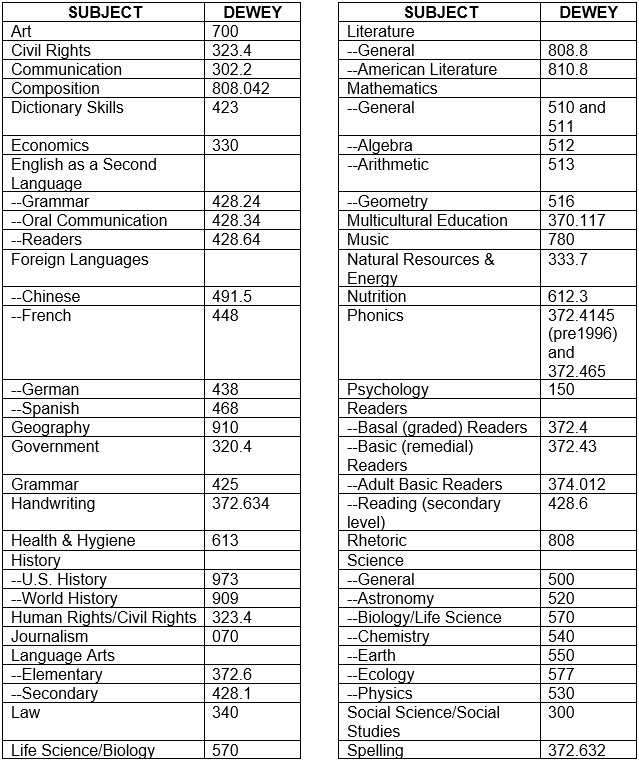Guide to the Curriculum Collection
About the Collection | Find Curriculum Materials | General Sources | Current & Historical Textbook Directories | Diverse Populations | Subject Areas | Call Numbers
About the Collection
Overview
The Curriculum Collection (CC), located in the Social Sciences, Health, and Education Library (SSHEL), is representative of only part of the vast core of materials related to teacher education at the University of Illinois at Urbana-Champaign Library. The emphasis of the CC is on textbooks, curriculum guides, and related multimedia materials. The CC is supplemented and enhanced by the School Collection of children’s and young adult books which is housed in the same room. The primary purpose of the Curriculum Collection is to support the instructional programs of the College of Education and the methods courses in the subject disciplines for preparation of early childhood, elementary, and secondary school teachers. Together with the S-Collection, it serves the curriculum needs of the children’s literature courses taught in the College of Education and the School of Information Sciences (iSchool).
The goals of the Curriculum Collection are as follows: to maintain a collection of items for use by students and teachers that is accessible during daytime, evening and weekend hours; to reflect as many different philosophies of education as possible; to provide materials of interest to varied ethnic, racial, and other multicultural groups; to maintain a representative historical collection of textbooks for examination and research purposes; to provide a reference collection of guides to curriculum materials; and to selectively acquire textual materials from those school districts to which University of Illinois student teachers are assigned.
Materials in the Curriculum Collection
The Curriculum Collection contains the following materials:
- Textbooks and textbook series from major publishers in the following areas: English/Language Arts, English as a Second Language (ESL), Fine Arts, Foreign Languages, Health/Safety, History/Geography, Literacy, Mathematics, Multicultural, Reading, Science, Social Studies, and Special Education; limited materials are also available for Adult Basic Education and Early Childhood Education
- Curriculum guides
- Selected multimedia material
Because of space and budgetary considerations, the following restrictions are observed: materials in the Curriculum Collection do not duplicate items in the University Library unless strong need is shown. A selective collection of music materials is maintained in the Music and Performing Arts Library. Typically, materials published within the last ten years are located in SSHEL and circulate for 2 weeks; older materials are located in the Oak Street storage facility and circulates for 4-16 weeks.
Organization
The Curriculum Collection is organized in three sections: curriculum guides, textbooks, and kits. Each section is designated by a prefix added to the call number:
- CURR : Curriculum Guides
- KIT : Kits
- TEXT : Textbooks
Materials may be located under each prefix within a given subject area. Within each prefix, materials are assigned Dewey Decimal call numbers according to subject and are physically arranged in a Dewey classification sequence. Materials which cannot be located in the CC may be borrowed from other state schools using I-Share, the statewide library catalog, or may be acquired through Interlibrary Loan (ILL). Research-oriented and theoretical works are included in the SSHEL Stacks.
Resources Related to the Curriculum Collection
- Guide to Finding Lesson Plans
- Locating Basal Readers
- Guide to Curriculum Materials that Utilize Children’s Trade Books
- Selected Internet Resources for the Curriculum Collection
- Historical Curriculum Materials
- School (S-) Collection
Find Curriculum Materials
When searching the Library Catalog for curriculum materials, an excess of non-curriculum material is often found by the catalog. However, there are two specific ways of searching the catalog for curriculum materials only.
1. Most curriculum materials have subject headings which combine the subject of the material (history, English, economics, etc.) with the subject “study and teaching.” Either the Advanced Search or Basic Search may be used. When using the Advanced Search, enter the subject (history) in the first search box and select “Subject” from the drop down menu. Then, in the second search box, enter “study and teaching” and again select “Subject” from the drop down menu.
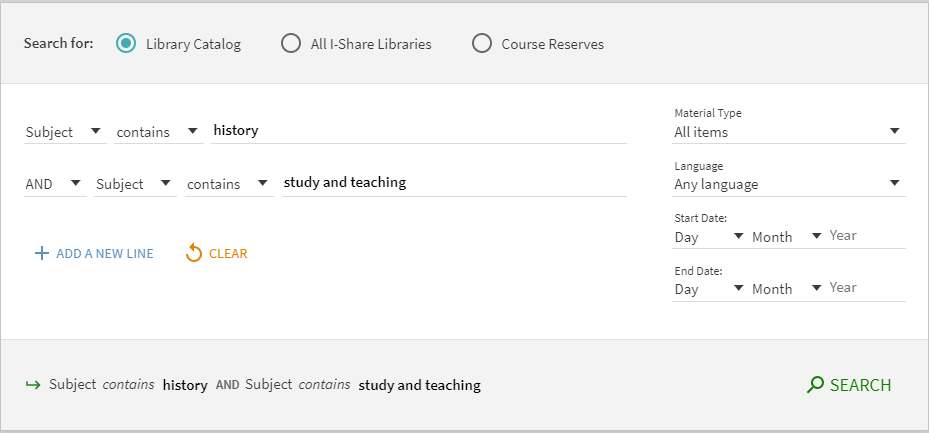
A similar search may be conducted in the Basic Search by entering the subject plus study and teaching, i.e. history study and teaching, and selecting “Subject” from the drop down menu. To further refine the search, include elementary or secondary in the search, i.e. history study and teaching secondary. Including secondary in the search may also retrieve some college-level materials.
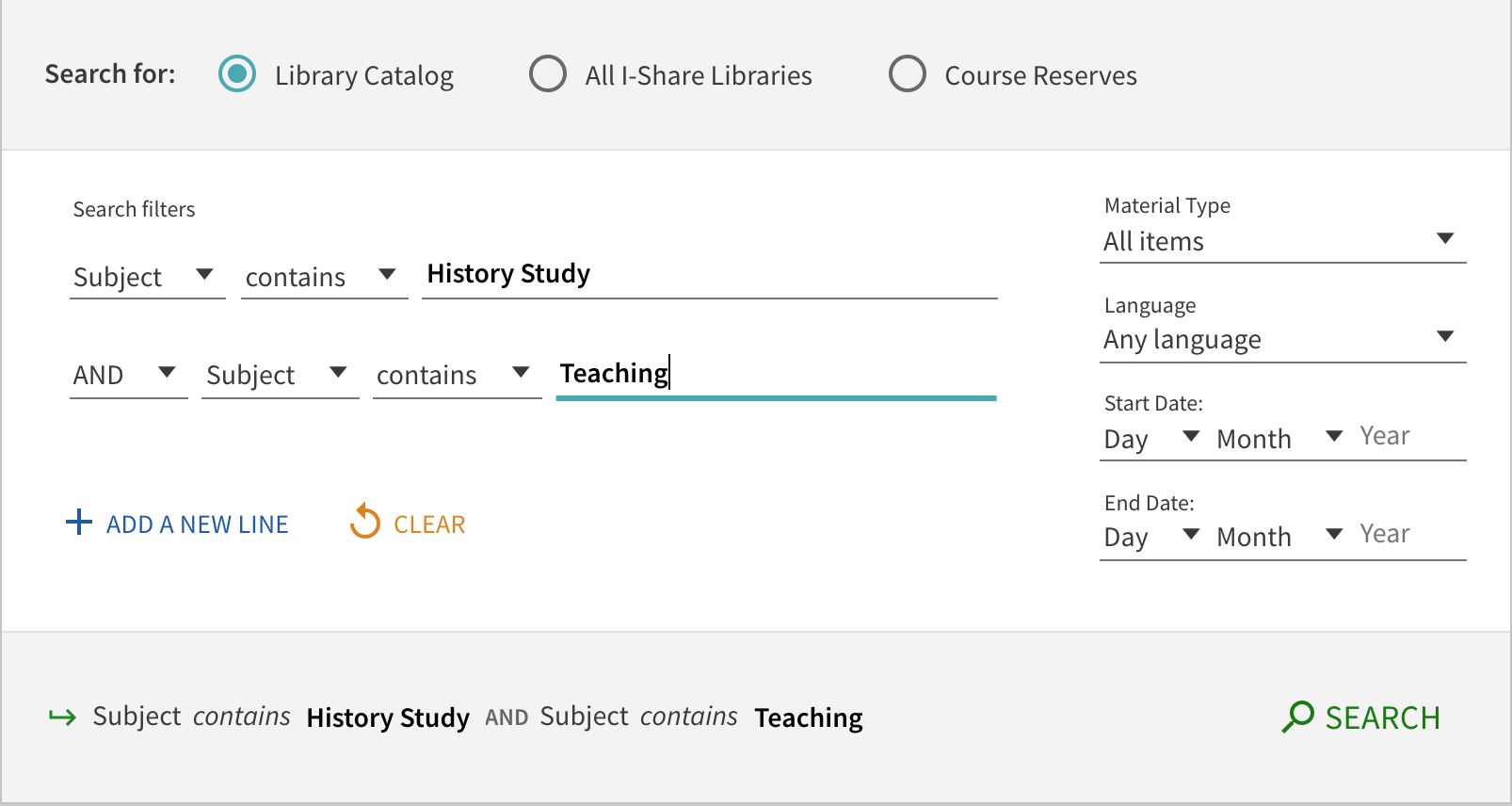
Either of these searches should find curriculum materials related to the subject you are searching for. Please remember to check that the location of the material is “SSHEL Curriculum” for current material. Older items will be located in Oak Street with a TEXT or CURR prefix.
- The second type of search must be done using the Advanced Search screen. Enter the subject in the first search box and select “Subject” from the menu. Then, in the second search box enter one of the call number prefixes listed above and select “Call Number” in drop down menu.
This is especially useful if searching specifically for textbooks (TEXT.) or curriculum guides (CURR.). This technique can also be used to locate specific materials, including kits (KIT), games (GAME), CD-ROMs (CDROM), flashcards (FLCRD), videorecordings (VIDREC), music CDs (CDISC), and DVDs (DVD).
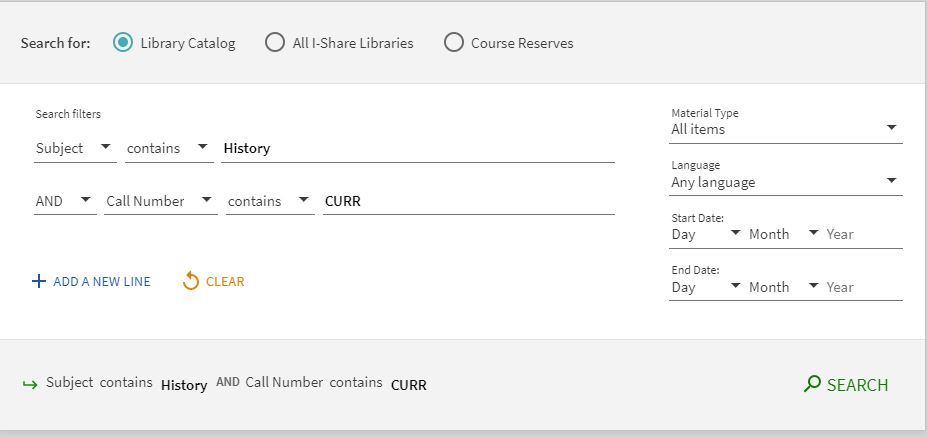
General Sources
CURR. 011.62 NEASCH 2010
Neal-Schuman guide to recommended children’s books and media for use with every elementary subject. 2nd ed. 2010. (Oak Street)
A resource to help teachers and librarians incorporate books and multimedia materials into everyday learning.
372.6044 Us41
Using Children’s Literature Across the Curriculum: a Handbook of Instructional Strategies. 2011. (Main Stacks)
A guide to help teachers design critical literacy instruction for grades K-8. Each instructional sequence provides strategies to incorporate literature into lessons, learning outcomes, correlations to national standards, rubrics for assessment, differential instruction strategies, suggested activities, and discussion.
Current and Historical Textbook Directories
Current and Historical Textbook Directories
The Curriculum Collection includes materials dating back to the early 1800s. Most of these materials are textbooks, but some older curriculum guides are also available. The strength of the historical portion of the collection is in materials published from 1880 to 1980, although older materials are also available. Textbook series, primers, geographies, arithmetic books and many other areas are included in the historical segment of the collection. Over 58,000 books are available with records in the library catalog and include items published between 1800 and the present. For further information about older schoolbooks, see Historical Curriculum Materials.
MFICHE 428.6 AM35
American Primers. 1990. (HPNL)
A microfiche collection of over 800 primers, readers, spelling books, alphabet books, teaching manuals, and non-instructional juvenile books from the early 18th century to the mid 1930s. The guide includes an introductory essay and bibliography. Includes combined author/illustrator/publisher, title, and chronological indexes.
Directory of Curriculum Materials Centers and Collections, 7th ed., 2015. (online)
This directory contains data from over 160 institutions that house curriculum collections. Each institution’s entry includes information about the size of the collection, the budget, types of materials collected, and contact information for staff. Also included are multiple appendices that aggregate data from the entries.
Q.011.70973 D628
Directory of Historical Textbook and Curriculum Collections. 2005. (SSHEL Reference)
This is a directory of educational institutions and publishers with historical curriculum collections (i.e. published prior to 1980) in the United States and Canada. Includes survey responses from 58 institutions and publishers that describe the size, dates, and focus of each collection as well as access, collection development, and preservation practices. Appendices provide the original survey, additional identified collections, unique collections, and further resources. Extensive indexes are also included.
S.011.7 Un3e
Early American Textbooks, 1775-1900. 1985. (S-Collection Reference and Online)
Subject guide to a representative selection of the Early American Textbook Collection located at the U.S. Department of Education. Books for supplementary reading are listed with the textbooks.
S.016.37132 EL39
El-Hi Textbooks and Serials in Print. 1985-. (S-Collection Reference)
Inclusive list of elementary, middle, and high school textbooks and periodicals currently available for purchase. Arranged by subject with author, title, series and serial indexes. Published annually. The most recent volumes are in S-Collection reference, while older volumes are kept in the Oak Street Storage Facility.
Diverse Populations
S.016.027 L616h
High/Low Handbook: Best Books and Web Sites for Reluctant Teen Readers. 4th edition. 2002. (Oak Street)
Provides book and website recommendations for teens who are reluctant readers. The first section provides basic information about high-interest books and websites created specifically for reluctant teen readers, while the second section covers books written for young adults that are easy to read and high-interest. Author, title, and subject indexes are also included.
Integrating African American Literature in the Library and Classroom. 2011. (online)
Provides cross-curricular lesson plans integrating more than 200 books that deal with African American life from slavery to the 21st Century. The lesson plans are organized into chapters by subject including arts, sports, education, family and friends, and more. Grades K-12.
S.028.1624 N143r
Rainbow Family Collections: Selecting and Using Children’s Books with Lesbian, Gay, Bisexual, Transgender, and Queer Content. 2012. (S-Collection Reference)
Includes synopses, awards, professional review citations, and suggestions for librarians considering acquisition for more than 250 books with LGBTQ content from around the world. Also provides a short historical overview of LGBTQ books for children, LGBTQ book awards and tips for developing welcoming library spaces.
Subject Areas
375.001 C857a
Aligning Your Curriculum to the Common Core State Standards. 2012. (Main Stacks)
This book is intended to help educators implement the Common Core State Standards (CCSS) and develop local curriculum models to help improve student performance. It provides an overview of the CCSS, explores issues related to curriculum and a national model, details techniques to develop and use a local CCSS model, provides a sample curriculum, and examines issues educators anticipate moving forward. Also includes appendixes with sample forms and an index.
CURR.973 PEAB2005
America’s History through Young Voices: Using Primary Sources in the K-12 Social Studies Classroom. 2005. (Oak Street)
Provides text for primary resources, including diaries, letters, and essays, combined with teaching strategies and lesson plans to integrate them into the classroom.
CURR 372.6 JOSSEY2012 A-C
Common Core Curriculum Maps in English Language Arts. 2012. (SSHEL Curriculum, Oak Street)
Presents research-based curriculum maps created by teachers to teach to the English Language Arts Common Core State Standards for grades K-5, 6-8, and 9-12.
CURR. 511 FULCR1998
Exploring Math with Books Kids Love. 1998. (Oak Street)
Provides lesson plans that integrate literature and mathematics, including basic math computation, statistics, algebra, and geometry. Includes graphs, charts, and other exercises for students, as well as answer keys for all activities.
Integrating Young Adult Literature Through the Common Core Standards. 2013. (online)
Describes how to use young adult literature in conjunction with inquiry-based learning to teach to the Common Core State Standards (CCSS). Part one examines the model of text complexity in the CCSS and demonstrates how young adult literature can help students understand this concept. Part two provides discussion and analysis of the Standards and presents concrete teaching examples using young adult literature.
CURR. 500 NSTA2013B
Even More Picture-Perfect Science Lessons, K-5: Using Children’s Books to Guide Inquiry. 2013.
Contains 15 lessons that integrate science and reading standards. Connects the lessons to Framework for K-12 Science Education and the English Language Arts and Literacy Common Core Standards. Lessons are appropriate for grades K-5.
CURR. 372.4 LIBUN2010
Reading the World with Picture Books. 2010. (Oak Street)
Introduces the seven continents and then breaks each continent down to its countries. Each country is given a brief introduction with a list of several picture books from or about that country. Short activities, games, poems, and quizzes are interspersed.
S.016.808 H147u v.4
Using Picture Storybooks to Teach Literary Devices: Recommended Books for Children and Young Adults. v.4. 2008. (S-Collection Reference)
Explains how to use picture books to illustrate various literary devices such as imagery, metaphor, and theme. Lists the literary devices alphabetically and gives a definition, examples and a list of picture books that utilize the device for each.
Call Numbers
How to Read a Curriculum Collection Call Number
The Curriculum Collection houses a variety of materials to assist teachers and teacher education students. Due to the unique nature of textbooks, curriculum guides, and kits cataloged within the curriculum materials, there are a variety of call number elements to distinguish between distinct types of materials. Most Curriculum Collection call numbers are made up of five elements, each starting a new line of the call number.
Sample Curriculum Collection Call Numbers
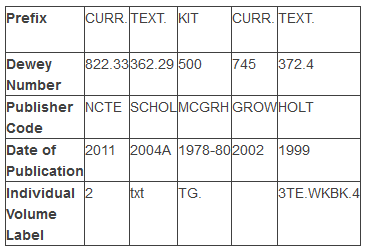
Prefix: The three most common prefixes in the Curriculum Collection are:
- TEXT.: Printed materials that would be used by students (such as textbooks) and/or their supplementary or accompanying materials, such as teacher’s guides and workbooks.
- CURR.: Guides, outlines, lesson plans, programs, and overviews. The distinguishing feature of CURR. materials is that they have no accompanying student textbooks or materials to be used by students, but provide resources for teachers.
- KIT: Materials that are packaged together in a set in order to teach a certain topic. They often include materials such as videos, music CDs, maps, charts, and other supplementary materials.
- Other prefixes are used for specific formats such as games, DVDs, and so on.
Dewey Number:The materials in the Curriculum Collection use specific Dewey numbers that have been established for the collection over time. The numbers in the examples above are for the following categories: Shakespeare (822.33), Substance Abuse (362.29), General Science (500), Folk Art (745), and Reading (372.4).
Publisher Code: The publisher code is a four-to-six letter code unique to each publisher of materials in the Curriculum Collection. The code is usually made up of letters in the publisher’s name. In the examples above, the publishers are the National Council of Teachers of English (NCTE), Scholastic (SCHOL), McGraw-Hill (MCGRH), Grow Publications (GROW), and Holt, Rinehart, Winston (HOLT).
Date of Publication: This is the date printed in the item. However, in the second example above you see the letter “A” after the date. This is to indicate that there are two books (or sets of books) that fall under the same call number and year. The letter after the years is used to differentiate between them. For example, if a publisher releases three sets of books in the same year called American History, American History: Beginnings to 1866, and American History: 1867 to Today. The original set will have no letter after the publication date. The second set will have an “A” and the third set will have a “B”.
Individual Volume Label: The last line of a Curriculum Collection call number tells you more specifically what each volume in the collection consists of. Nearly All TEXT. and KIT materials use individual volume labels, while most CURR. materials do not. However, sometimes a publisher will release several volumes of a curriculum guide. In that case, the individual volumes would be labeled 1, 2, and 3. In the first example above, the book is the second volume in the set. The most commonly used suffixes include:
- txt (student text)
- TE (teacher’s edition—includes a replica of the student text in the book)
- TG. (teacher’s guide—does not include a replica of the student text in the book)
- WKBK. (workbook)
- sup. (supplementary material)
- tests
- forms (duplicating worksheets, also called “blackline masters”)
- chart (posters)
- key (answer key)
- CDROM
Suffixes can also be combined as necessary. “TE.WKBK.” is a teacher’s edition of a workbook while “TG.sup.” is a supplement to a teacher’s guide. A number before the suffix indicates either the grade or the level (if books come in Levels A-D, we will label them 1-4). A number after the suffix indicates the specific volume of the book with that call number/suffix. For instance, in the last example above, the volume is the fourth teacher’s edition of a workbook for third grade/level three.
Frequently Used Call Numbers by Subject for the Curriculum Collection
Call numbers are groups of numbers and/or letters that classify library items by subject. Items are arranged on bookshelves by call number. The Curriculum Collection uses Dewey Decimal Classification.
